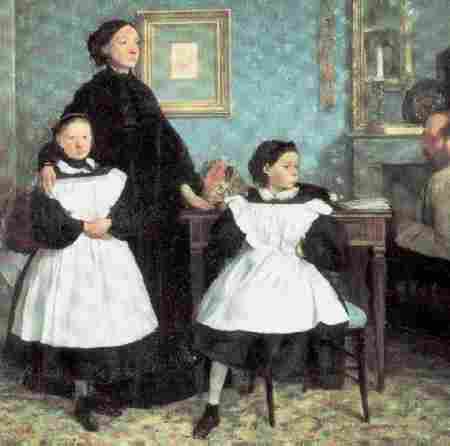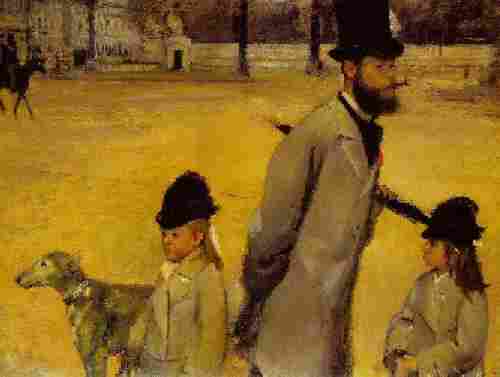
Artists Illustrating Boys' Fashions: Edgar (Hilaire-Germain-) Degas, 1834-1917

Figure 1.--Degas painted relatively few domestic scenes. This Degas painting show typical white pinafores
that French girls wore at home. The painting of the Bellini sisters was executed about 1959-60. He worked on the painting over an
extended period and then wanted in back from the family.
|
Edgar Degas was acknowledged as the master of drawing the human figure in motion. He was probably the greatest 19th Century draftsman. Many historians consider him to have been the
most intelligent and original artists of all the impressionists. His work is characterized by innovative composition, skillful drawing, and perceptive analysis of movement made him one of the masters of modern art in the late 19th century. He
was profoundly influenced by Japanese art. Degas worked in many mediums, preferring pastel to all others. He is perhaps best known for his paintings, drawings, and bronzes of ballerinas and race
horses-both of which required a mastery of handling motion.
Boyhood
(Hilaire-Germain) Edgar De Gas was born in Paris on July 19, 1834.
As an adult, he changed the name to Degas. Edgar was the son of a wealthy banker, and his aristocratic family
background instilled into his early art a haughty yet sensitive quality of detachment. His father, Auguste, headed the Naples branch of the family bank. Edgar's grandfather had fled to Naples from Paris during
the Revolutiionary Terror of 1793. His fiance had been guillotined.
His son Auguste was born in Naples and mairred a New Orleans Creole.
Auguste preside over a solid bourgeois family in which Edgar grew up.
He was an enthusiastic patron of the arts. He played the organ in church and regularly patronized musical gatherings.
Education
Edgar received a rigorous classical education and his father wanted
him to pursue the law. Edgar finally abanoned his law studies to
pursue his love of art. His father objectedm, but eventually gave in
to the inevitable.
As Degas grew up, his idol was the painter Jean
Auguste Ingres, whose example pointed him in the direction of a classical draftsmanship, stressing balance and clarity of outline.
He began his artistic studies with Louis Lamothes, a pupil of Ingres. He then studied at the École des Beaux-Arts under a disciple of the famous French classicist J. A. D. Ingres, where
Degas developed the great drawing ability that was to be a salient characteristic of his art. He regularly copied the great studies in the Louvre to help develop his skills.
He left the École des Beaux-Arts in 1854 and went to Italy. He stayed there for 5 years, studying Italian art, especially Renaissance works.
Personal Life
Degas never mairred and had no children. Perhaps he felt that his
art demanded his total concentration. He wrote to a friend, "I have
been reflecting ... on celibecy and three-quarters of what I have been saying to myself is sad." He did think that a man should marry, adding "You don't know what the solitude of old age is like." As to why he
did not follow his own advise, "I was too afraid of hearing my wife say after I had finished a painting. 'Thar's a pretty thing you have done ther.'"
He was reportedly charming and amiable to those he loved, especially
his nieces and nephews. But he could cutting and severe with friends. After the Dreyfuss Affair broke he became virulently anti-Semetic and
broke with long-time Jewish friends.
Career
Returning to Paris in 1859, he painted portraits of his family and friends and a number of historical subjects, in which he
combined classical and romantic styles.
After 1865, under the influence of the budding impressionist movement, he gave up academic
subjects to turn to contemporary themes. But, unlike the impressionists, he preferred to work in
the studio and was uninterested in the study of natural light that fascinated them. He was
attracted by theatrical subjects, and most of his works depict racecourses, theaters, cafés,
music halls, or boudoirs. Degas was a keen observer of humanity--particularly of women, with
whom his work is preoccupied—and in his portraits as well as in his studies of dancers, milliners, and laundresses, he cultivated a complete objectivity, attempting to catch his subjects
in poses as natural and spontaneous as those recorded in action photographs.
In Paris, Degas came to know Édouard Manet, and in the late 1860s he turned to
contemporary themes, painting both theatrical scenes and portraits with a strong emphasis on the social and intellectual
implications of props and setting.
He put aside his easel in 1871 to volunteer in defending Paris from
the Germans. After the fall of Paris, he left to visit his brothers
in New Orleans, but missed Paris,
In the early 1870s the female ballet dancer became his favorite theme. He sketched from a live model in his studio and
combined poses into groupings that depicted rehearsal and performance scenes in which dancers on stage, entering the stage,
and resting or waiting to perform are shown simultaneously and in counterpoint, often from an oblique angle of vision. On a visit
in 1872 to Louisiana, where he had relatives in the cotton business, he painted The Cotton Exchange at New Orleans
(finished 1873; Musée Municipal, Pau, France), his only picture to be acquired by a museum in his lifetime. Other subjects from
this period include the racetrack, the beach, and cafe interiors.

Figure 2.--Degas paintings of contemporary life provide interesting details about every day Parisian fashions. I do not know, however, if the children pictured in this 1875 painting were boys or girls.
|
Degas study of Japanese prints led him to experiment with unusual visual angles and asymmetrical compositions. His subjects often appear cropped at the edges, as in Ballet Rehearsal (1876, Glasgow Art Galleries and Museum). In Woman with Chrysanthemums (1865, Metropolitan
Museum of Art, New York City), the female subject of the picture is pushed into a corner of
the canvas by the large central bouquet of flowers.
Degas' eyesight began to fail in the 1880s. This may have been why Degas, unlike many of the other impressionists, did not like to
paint in the open. Apparently the harsh sunshire hurt his
eyes. As a result,
he began increasingly to work in two new
media that did not require intense visual acuity: sculpture and pastel. In his sculpture, as in his
paintings, he attempted to catch the action of the moment, and his ballet dancers and female
nudes are depicted in poses that make no attempt to conceal their subjects' physical exertions.
His pastels are usually simple compositions containing only a few figures. He was obliged to
depend on vibrant colors and meaningful gestures rather than on precise lines and careful
detailing, but, in spite of such limitations, these works are eloquent and expressive and have a
simple grandeur unsurpassed by any of his other works.
Degas was not well known to the public, and his true artistic stature did not become fully appreciated until after his death. In fact,
he only was able to hold a single one-man show during
his life time. His art was beginning to be recognized in his later
years. Upon learning that a painting he has sold for $100 had sold for $95,700, he said, "I feel like a horse that wins the Frand Prix and gets a bag of oats." He died in Paris on September 27, 1917.
Subjects
There are many great paintings to remind us that the artists of the Impressionist age were sensitively aware of contemporary life.
Among the supreme masterpieces of the century are Degas's pictures of the ballet and its dancers. The impulse towards
painting the contemporary scene came to him not only from Courbet and Manet but from his friend, the critic Duranty, the
exponent of the aesthetics of naturalism. Yet in the particular direction of his tastes and his conception of design he was entirely
individual. To study and convey movement was a chosen task, first undertaken on the race course and then in his many pictures
of the Opera, viewed from behind the scenes, in the wings, or from the orchestra stalls during a performance.
There are aeveral Degas paintings showing contemprary Parisian life. He was particularly interested in painting girls and women. There are
few paintings showing boys' fashions. A few paintings show French home life and typical dress. The painting of the Bellini sisters show the crisp white pinafore popular during the late 19th Century. A few
street scenes show children's fashions.
Assessment
Hilaire Germain Edgar Degas was one of the French impresionist masters of late 19th Centuyry France. His art reflects a concern for the psychology
of movement and expression and the harmony of line and continuity of contour. These characteristics set Degas well apart from the other impressionist painters, although he took part in all but one of the 8
impressionist exhibitions between 1874 and 1886. Degas is usually classed with the impressionists, and he exhibited with them in seven of the eight impressionist exhibitions. However, his training in classical drafting and his dislike of painting
directly from nature produced a style that represented a related alternative to impressionism.
Christopher Wagner
histclo@lycosmail.com
Navigate the Boys' Historical Clothing Artist pages:
[Return to the Main arrtist page]
[Chronology]
[Countries]
[Individuals]
[Styles]
Navigate the Boys' Historical Clothing Web Site:
[Introduction]
[Chronology]
[Clothing styles]
[Biographies]
[Bibliographies]
[Activities]
[Countries]
[Contributions]
[Boys' Clothing Home]
Created: February 29, 1999
Spell checked: July 30, 1999
Last updated: August 10, 1999



